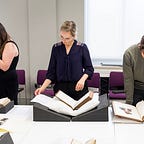An update with AHRC-NEH Indigenous Knowledges research assistant, Sarah French.
I’ve now finished my placement with Wellcome Collection, and a blog post update on the Indigenous Knowledges project is well overdue. I have been a little consumed with the other project work — including participating in our latest Digital Sprint event that we’ll post about shortly — and therefore the blog post has moved further down my list of priorities. It’s also difficult to know exactly what to write about. This work takes time, its complex, and we’re only in an exploratory phase so it will offer more questions than it does answers.
To backtrack, Indigenous Knowledges is a one-year project funded by the USA’s National Endowment for the Humanities and the UK’s Arts and Humanities Research Council to focus on digital scholarship in cultural institutions. It was developed collaboratively by staff at the University of Kent, the University of Arizona, Diné College, and Wellcome Collection. The project questions how to form reciprocal relationships with Indigenous communities, in this case with a tribal college library, and how cultural institutions can implement digital tools to support this work. As we have found, relationship building is by far the largest part of this work. We must commit to meaningful, long-term commitments and generate trust. The digital element, like using Local Contexts, can help to do this, but it doesn’t replace the groundwork that needs to take place on both a personal and institutional level.
A major component of the project has been an exchange between research fellow, Rhiannon Sorrell, who is assistant professor and librarian at Diné College on the Navajo Nation, and myself. Rhiannon visited the UK at the end of July 2022, meeting staff and colleagues at Wellcome Collection, the British Library, and the British Museum. She also had me join her in running a 5k around Hyde Park in support of Ukraine! I don’t think Rhiannon will mind me saying that this visit was challenging at times and that she felt the pressures of being the Indigenous voice as we focused on outputs for the project. One of Rhiannon’s highlights was meeting the Murrup Barak group from the University of Melbourne when they visited Wellcome Collection on Rhiannon’s first day. The Aboriginal and Torres Straits Islander students were on a similar visit to the UK for the summer to premiere their documentary film, Warriors, at King’s College London and explore their Indigenous identities. It was this serendipitous meeting, and Wellcome Collection’s willingness to facilitate this, that felt pertinent to the conversation.
I was reunited with Rhiannon on the Navajo Nation in October. This is the largest tribal reservation in the USA and covers part of Arizona, New Mexico, and a small portion of Utah, including Monument Valley. I learnt a lot from Rhiannon and everyone I met, from the tour guide at the lodge where I was staying, from Mary who kindly drove me to Diné College each day, and from staff and intern students on the campus. We heard how the leadership team is keen to further Diné College as a research institute and build relationships with cultural institutions. However, hesitancy was still felt within the community as a result of extractive research projects that have gone before and continue today. The college has a core commitment to teach Navajo culture and serve the community, and any partnership developed out of a non-Indigenous institution needs to fulfil this commitment too.
On the second week of my trip, Rhiannon and I took a road trip off the reservation to Flagstaff, Arizona. Here we met archivists Sam Meier and Peter Runge from the Cline Library at Northern Arizona University. Their predecessors started considering issues around culturally sensitive Indigenous materials in the archives in the 1990s and from then worked to develop the Protocols of Native American Archival Materials to establish methods of best practice for the culturally responsive care and use of these. These have now been endorsed by the Society for American Archivists and are widely used across the USA today, as we later witnessed at the ATALM conference.
At ATALM, the conference for the Association of Tribal Archives, Libraries, and Museums, we heard about several projects that have been using digital tools to work with Indigenous communities. The joy that the Tribal Digital Stewardship Cohort Program from Washington State University had fostered amongst its participants was palpable in the room. Others shared how the Mukurtu platform had served community needs, whilst there was a clear understanding of the limits of digital repatriation. It was also great to hear more from Rhiannon and Professor Jennifer Jenkins, the co-PI of Indigenous Knowledges, on the next iteration of their Tribesourcing Southwest Film project.
To kickstart this year, we (Wellcome colleagues, Kent students, project partners) will meet this week for our next Reading Group. In previous sessions, we have read seminal texts, like Linda Tuhiwai Smith’s Decolonizing Methodologies (1999), Sean Wilson’s Research is Ceremony (2008) and Eve Tuck and K. Wayne Yang’s ‘Decolonization is not a Metaphor’ (2012). We’ve also watched Reel Injun (dir: Neil Diamond, 2010) and listened to Christine Ami’s podcast episode for Where We Meet, a series from the Taos Center for the Arts. This time round, we will discuss the Protocols to explore how these might work for cultural heritage institutions in the UK.
